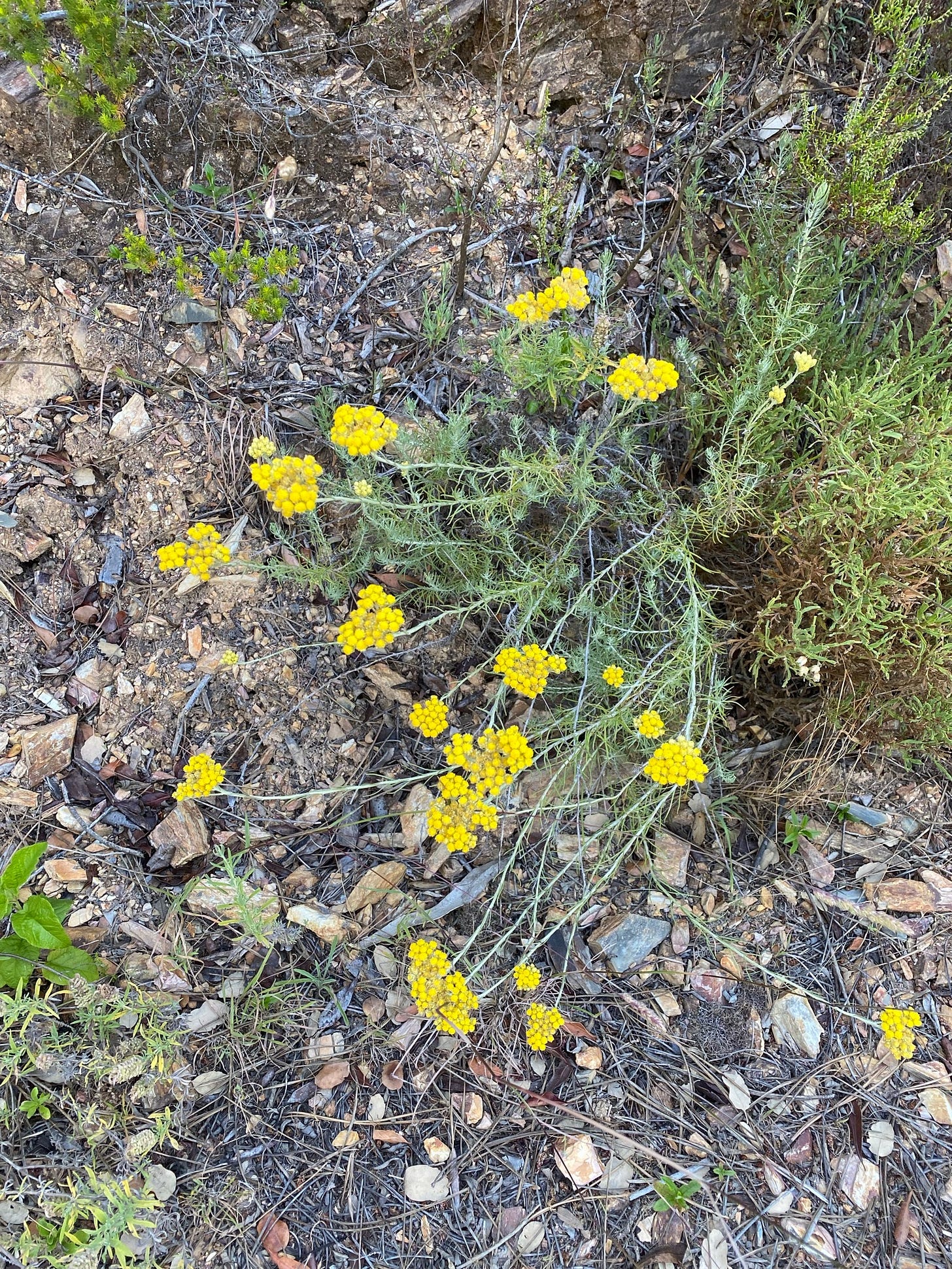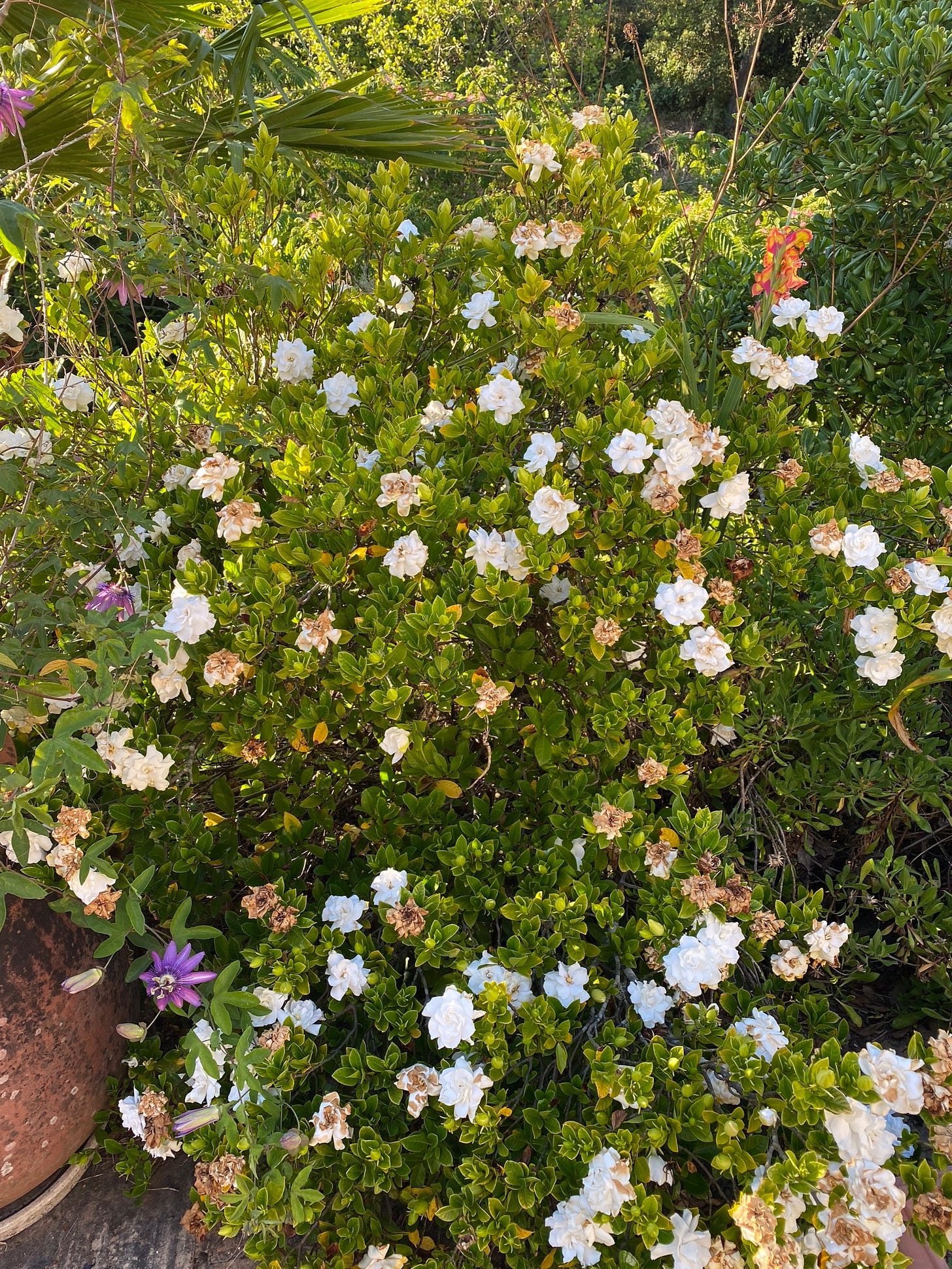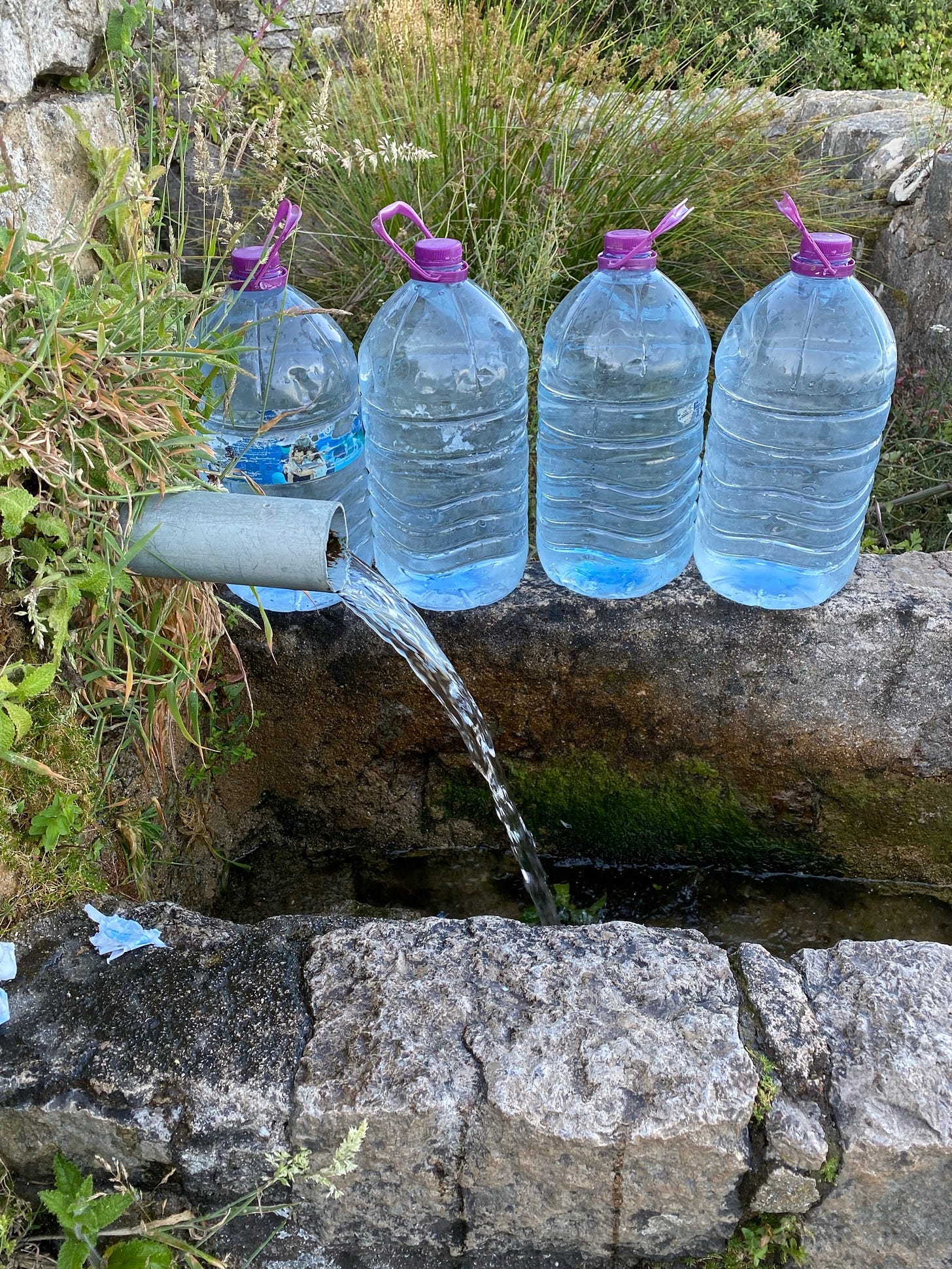I’ve become quite known among friends for being able to “talk for England” but now, on my own for several weeks, my blogging seems to be a substitute for speech. When I first said to Simon that I would aim to post every week he looked surprised, as if I’d never find enough to write about, but here I am on blog three within week one. I know, it’s new and I’m enthusiastic but I have multitudes of thoughts about subjects so I’d better commit some to paper (no longer an appropriate term in this internet age) before I have more blonde moments and forget what I wanted to write.
As I walked Obi around the track the other day I stopped to admire a Curry plant (Helichrysum italicum) with it’s yellow flowers and grey-green foliage. It goes by many other common names but I’m happy to stick with Curry plant because it lives up to that name with it’s intense smell. In our early years in The Algarve it was the scent which alerted me to it. There was an all pervasive curry smell as we walked across some sand dunes towards a beach. It’s a great plant, used in gardens all over the world, including in theUK.
The flowers are long lasting and can be used cut fresh or dried. Apparently it can be added to flavour food when cooking, and a red essential oil can be extracted. No, I don’t have shares in marketing it. I just enjoy the fact that it’s growing wild all around us, and it moved my scatterbrained, sometimes peculiarly lateral thinking onto other herbs and fragrances which so many people are capable of walking past with their eyes and nostrils open but not seeing or smelling.
Every year I see wild Thyme in flower by the roadsides when driving along the coastal roads. I’m one of those dreadful drivers with most of my attention on the road but a worryingly significant portion of it on the verges. I can bring the car to a halt and run back to check on a wild flower that caught my attention, and when I first saw the pale lavender flowers on small shrubby plants I didn’t recognise them until I was able to park up and take a closer look. They are understatedly stunning, sometimes a dominant, small, woody shrub, eking out an existence on poor, dry sandy soil with deep roots finding enough moisture to stay alive but almost leafless during the scorching summers. In winter and early spring they burst into life and when I stop to look at them and run my hand across their new growth, the strength of their Thyme scent is wonderful. We mainly grow a soft, round leaved species but the scent and flavour is nothing when compared to these native, drought resistant, needle leaved beauties. I see them but no-one I know has ever mentioned them. They certainly understate their presence and don’t scream out “look at me, I’m here!”
On our land we have an abundance of wild marjoram and oregano. They are closely related botanically and apparently the Spanish use the same name for both, but their scent and flavour are so different. It’s almost impossible to work anywhere on our land without brushing against one or the other, or without grabbing some small plants when weeding and then one’s sense of smell is kicked into action by either the minty aroma of our local marjoram or the intensely characteristic scent of the oregano. We try to pick the marjoram new growth in spring before it’s honeycombed by leaf-miners. We dry it, often in a tray on the wood burning stove, and use masses later in the year when we make and bottle oven roasted tomato sauce. Thanks Delia for that gem of a recipe, and yes, it’s usually roasted with home grown garlic. Harvesting some oregano is on my “very soon to do list.” We copy the Portuguese and cut the stems just as it starts to flower but before the tiny white flowers go brown. The intensity of flavour of the flower heads seems to far exceed that of the leaves, and soon I will be hanging huge bunches to dry behind the house. Just writing about it makes me want to make pizzas and then our roasted tomato sauce or plain old home made passata goes on with the oregano first. I nearly forgot to mention that a small pinch of oregano transforms scrambled eggs. (Can someone tell me why Americans pronounce it as if it’s spelled “orageno”?)
We have masses of wild lavender on our hillside, but sadly we missed it’s flowering this year. Quite a few people seem to like flavouring foods like jams, jellies and even ice-cream with it but we’re totally of the opinion that lavender belongs in clothes drawers, bathrooms, old ladies handbags or maybe under a pillow, but NOT in the kitchen.
Another really strongly scented plant is Tulbaghia violacea. It’s not for the faint hearted and as our friend Gwen said “if I’d known how strong the scent was I’d never have planted it by the window.” It lives up to it’s common name of Society Garlic. The leaves look like Garlic Chives. Every part of the plant is edible and the flowers add a beautiful but strong touch of hot garlic to a salad. Just chewing one flower can make your breath smell for ages, but for garlic aficionados it’s a dream. (I like that word? A good friend, a professor of media studies once said that if you love opera and watch/listen to it all the time you’re described as an “opera aficionado.” If you like to watch pornography you’re a pervert!) I once thought that Tulbaghia might even deter wild boar, but sadly found that it doesn’t.
For culinary use we usually have a steady supply of Chives, Garlic Chives, Parsley, Lovage (soups and salad dressings) Parcel, Rosemary, round-leaved Thyme, Coriander and Dill can be erratic and rapidly go to seed but the latter is essential for bottling Gherkins, and let’s not forget Fennel. It grows everywhere along the roadsides, and we usually have some self seeded Bronze Fennel growing somewhere. Once I discovered that the beautiful Swallowtail butterfly caterpillars eat fennel I was happy to leave the plants, even though the sap can photosensitise your skin and leave you with purple, scarring burns. However, some years ago I saw some beautiful, luxuriant fresh fennel growth on the roadside and thought that a small amount in a salad would be nice. I stopped the car and picked some. Literally fifty metres along the road I stopped the car and threw it out. The strength of the Fennel smell was making me retch! Never again.
Having mentioned the vomit inducing stink of Fennel in a hot car, let’s switch to the beautiful scents of the Gardenia which flowers unfailingly through the summer in front of the house and the wonderful Jasmine which grows through an olive tree at the end of the house. Heavenly as we walk past.
The photo of the Gardenia also shows a passion flower in the lower left quadrant.
Aside from the assault on our senses from the herbs, the above mentioned Gwen wanted to know why I showed a bottle of water which seemed to have been bought in a supermarket in my first breakfast photo. It was intentional (though I don’t have any real interest or talent in the field of photography) and designed to give scale to the grapefruit which I could have been exaggerating about when I described it as “huge.” Gwen was insistent. I should explain that we collect our drinking water from a mountain spring. Here at Passil we have a well and an 80 metres deep borehole, but the water from these is too rich in iron. We have water rights on a bordering stream, but that water comes past many houses. We have a 50000 litre rainwater tank, but dead animals and bird poo on the roof could get in. If we used any of our water sources we would have to filter, purify, and probably chlorinate to make the water “potable” by EU standards, so we collect water to drink from a mountain spring and only use our borehole or rainwater for washing ourselves, our dishes, our clothes and to flush our toilets. (Where that goes is another story.)
This spring is close to the top of Foia. That’s nearly 900 metres above sea level and there are no houses above to pollute the water. I once collected water while a Water vole ate it’s supper and watched me!
I’m going to finish this blog with the question of “how is it that fresh water flows out of springs (quite a lot of them actually) 900 metres above sea level?” The water is always really cool, even on a scorching summer day and I have this idea that it is coming up through fissures in the volcanic, granite mountain because the enormous weight of this granite mountain puts so much pressure on the aquifers deep below, that the water travels up 900 metres and bubbles out of springs on the mountainside!
Is there possibly a smart arse (ie knowledgeable) geologist reading this who can enlighten me?
I have more fascinating “stuff” to write about, peaches, apricots, plums, potatoes, pine kernels and even palm trees! Tune in again to some riveting writing, it’s all coming soon.









Haha. Levenders! I have infused quince jelly last year and I enjoyed it. 😁
My portugese oregano brought here two years ago dued again. I hink if I wouldhave a 3rd chance I could grow finally on by choosing the suniest spot in the garden and forget about herbal gardeb corner! This is how far I get with reading since yesteday! ❤️
Hope to find time tomrrow to read your interesting comments on nature!